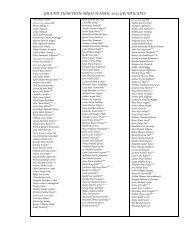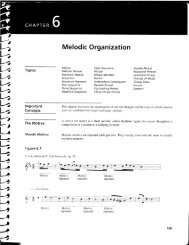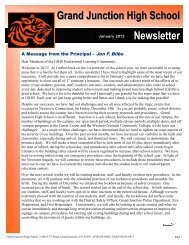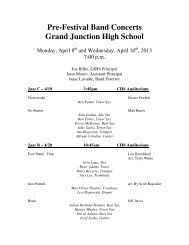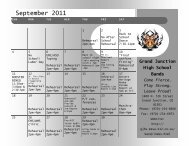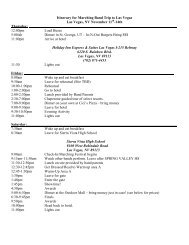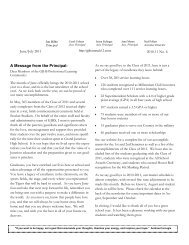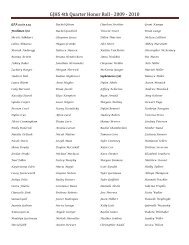< The Leading-Tone Seventh Chords -+
< The Leading-Tone Seventh Chords -+
< The Leading-Tone Seventh Chords -+
You also want an ePaper? Increase the reach of your titles
YUMPU automatically turns print PDFs into web optimized ePapers that Google loves.
-<br />
<<br />
zr-<br />
-rt<br />
I<br />
-<br />
A<br />
-t<br />
-+<br />
2<br />
-''<br />
)<br />
I<br />
?<br />
)<br />
--?<br />
Topics<br />
lmportant<br />
Concepts<br />
Lead ing-<strong>Tone</strong><br />
<strong>Seventh</strong> Chord<br />
Figu re 12.2<br />
<strong>The</strong> <strong>Leading</strong>-<strong>Tone</strong> <strong>Seventh</strong> <strong>Chords</strong><br />
<strong>The</strong> Half-Diminished<br />
<strong>Seventh</strong> Chord<br />
<strong>The</strong> Fully Diminished<br />
<strong>Seventh</strong> Chord<br />
Resolution of Tritones<br />
Resolution of Root and<br />
<strong>Seventh</strong> Factors<br />
Macro Analysis Symbols<br />
Both the vii'7 and viioT are associatecl very closely with the dominant scventh chord becausc<br />
they have three notesin<br />
cornmon with the V7<br />
Figure 12.1<br />
In Major<br />
CM: Vr vii"<br />
Threc tones in common<br />
CITT: V<br />
Three tones in comnton<br />
In the vii'7 the vri inclicates a chclrcl on the scventh scitle step. the ' shows that the qualitl<br />
of the chorcl is climinishecl-ntinor (also known as hul.f-climirtishetl). and the t rneans that it<br />
is a seventh chorcl. <strong>The</strong> o in the vii" clesigni,ltes a clirninished-diminished (usr.rally abbreviated<br />
to ditr-rinished or fLtllt' diminishetl) seventh chord. <strong>The</strong> vii" occurs in rnajor keys<br />
and thc viioT in minor keYs.<br />
Compclsers frequently sr-rbstitutc leading-tone triads and seventh chords for the dclminant<br />
to lencl varicty and diversification. In figule 12.2. Beethoven alternated the V7. \'iio".<br />
and 'n'iiot freely to represent dornittant harmony.<br />
IJccrhoren: Piano Sonata no.5. op. 10. ncl. I in C Minor. I (Allegro molttt c coll brio). l3-16.<br />
\(<br />
''' '4<br />
| ,, ... 'i<br />
.--,<br />
1<br />
/<br />
ln Hartnonic Minor<br />
All three of these chords represent dominant function<br />
217
Figure 12.3<br />
Since V7, viio7, and vi'1 all represent dominant harmony, composers intermixed them<br />
freely. In figure 12.3, the seventh (B-flat) of the viioT moves down to the root (A) of the<br />
V7 chord.<br />
Mozart: Piano Sonata, K. 283 in G Major, III (Presto), m. 64-69.<br />
DM: vii'7 V8 viioT Vq viioT Vl vii'7<br />
Progressi0ns fronr<br />
vii"7 and vli"l<br />
Figure 12.5<br />
a)<br />
CM:viiP! I6<br />
I st Inversion<br />
Resolution of<br />
l"ritane and<br />
<strong>Seventh</strong> Factons<br />
218<br />
h)<br />
Dominant harmony<br />
p<br />
V X I<br />
Like the dominant seventh, with which they share three common tones. vt1"7 and vlt']<br />
usually resolve to the tonic (I or i), either directly (figure 12.4a-b) or through the dominant<br />
seventh (fisure 12.4c-d\.<br />
FiE u re 12"4<br />
1<br />
e<br />
a<br />
u a<br />
CM: viirT I cm: vii o7 i CM: vii rr cm: vii o7<br />
V3 I<br />
. . a A<br />
cm: vll - x i6 CM: vii P{ 16<br />
I<br />
vq i<br />
Figure 12.5 shows resolutions of the leading-tone seventh chords in all inversions.<br />
ri<br />
? II<br />
I<br />
2nd Inversion<br />
1'<br />
l ft'<br />
f<br />
3rd Inversion<br />
.. oJ<br />
cm: viioj i6 CM: viie I rl<br />
cm: vll j it v<br />
<strong>The</strong> diminished seventh chord (vii"?) contains two diminished fifths, which tend to resolve<br />
inward. If both are resolved. the result will be a doubled third factor on the tonic<br />
chord (figure 12.6a), but composers often prefer the normal doubling, as shown in {igure<br />
12.6b.<br />
<strong>The</strong> 5tr-i.rc.tr.iral Flerrients of Music<br />
J a i t r<br />
)<br />
l t , t<br />
-<br />
a j,<br />
- a 1 t ; ! )<br />
I
1<br />
L<br />
-<br />
€-_<br />
-<br />
--<br />
=<br />
/t-<br />
-<br />
4<br />
.J<br />
-J<br />
1<br />
!r<br />
-J<br />
1<br />
1<br />
1<br />
)<br />
)<br />
1<br />
-t<br />
I<br />
Figure<br />
'12"7<br />
Figure 12.6<br />
<strong>The</strong> two tones in the leading-tone seventh chords (vn'7 and viioT) that are nearly always<br />
resolved are the root of the chord (the leading tone), which moves upward to the<br />
tonic note, and the seventh factor, which resolves downward by step.<br />
Mozart: Don Giovanni, K. 521 (Act I, Scene XIII), m. 1 1 6-117.<br />
bm:<br />
Macro Analysis<br />
Syrn<br />
bols<br />
Figure<br />
'12.8<br />
Beethoven: Sonata no. 5 in<br />
Cr '\:y<br />
Uneven 5ths okay<br />
,/n.,<br />
.<br />
| . . a \<br />
r vii '<br />
'\-rl<br />
In macro analysis, the harmonic motion involving leading-tone seventh chords is represented<br />
with a dotted slur. <strong>The</strong> following example illustrates prolongation of specific harmonies.<br />
To prolong means to lengthen the duration of a harmony through various musical<br />
devices. Many chorales have a harmonic rhythm of one chord per beat. In other forms of<br />
music. harmonies are often prolonged through measures of music, lasting for many beats.<br />
C Minor, op. 10, no. 1,I (Allegro molto e con brio), m. 1-10.<br />
Ii're <strong>Leading</strong>-Tclne<br />
<strong>Seventh</strong> <strong>Chords</strong> 219<br />
i<br />
il<br />
i
-------\- V<br />
a. f' -f<br />
t<br />
-?t<br />
l_:L<br />
-*r +<br />
l{erraissa ltce Pt'riocl<br />
{l{51)-16{X))<br />
lfaror;ue Period<br />
( I 6{X)-<br />
I 750 }<br />
Figure 12.9<br />
:<br />
V<br />
Elizabeth Jacquet cle la GLrerre: Suite in D Minor. Sarabande. nr. 21 2g.<br />
dnr:<br />
...,(r<br />
VII -5<br />
€'<br />
vii"i<br />
(-lassical lleriod<br />
( 1750- I tt25 i<br />
220<br />
o<br />
H istory<br />
<strong>The</strong> lcading-tone seventh chorcls were not characteristic<br />
o1'the rrusic of the Renaissar.rcc<br />
period.<br />
t)<br />
-1<br />
viio i<br />
With the ascendancy of the mii.ior-nrinclr tonal systent. leading-tone seventh chor-cls took<br />
their placc its part of the harrnonic vocabulrry. FigLrre 12.9 shows tvpical usc .f the 'ii.r<br />
during the baroclLre period.<br />
ib<br />
iipl<br />
<strong>The</strong> classical period continuecl the use of leacling-tone seventh chrlrcls with little change in<br />
apprclach lhlm the baroque. <strong>The</strong> illustration by Mozart in figure 12.10 is repr.csentativc clf<br />
the use of these chclrds in the classical pcriocl.<br />
<strong>The</strong> Structural Elements of Music<br />
N +<br />
)<br />
=<br />
i6<br />
:<br />
e<br />
-<br />
f><br />
-<br />
{<br />
-<br />
a<br />
--/.<br />
^a<br />
{<br />
{<br />
-1
-<br />
--<br />
-<br />
--<br />
/-<br />
/-<br />
--,<br />
--'<br />
-,<br />
-_,<br />
1<br />
-<br />
-<br />
-t-<br />
--J-<br />
/_,<br />
/_,<br />
I<br />
1<br />
_)<br />
-)<br />
-4<br />
1-<br />
-='<br />
-,<br />
t<br />
a<br />
Lr-<br />
f<br />
FiEure 12.1fi<br />
Mozart: Piano Sonata, K.284 in D Major, III (Variation V), m. l4-lj.<br />
Ronritntie l)t,riocl<br />
t1825--tr9(Xli<br />
Figure 12"'! 1<br />
IJ (ri) v7<br />
Wagner: Rienzi Overture, m. 346-352.<br />
Molto piu stretto<br />
Harmonic reduction:<br />
<strong>The</strong> romantic period saw a more relaxed and somewhat fieer use of leading-tone seventh<br />
chords. Figure 12.11 shows six consecutive diminished seventh chords in descencling<br />
chromatic motion. No Roman numeral analysis is given for the first five measures since<br />
functional harmony is temporarily suspended.<br />
Diminished seventh chords in parallel motion:<br />
ihe i-.eadinq-T11-1s<br />
5eventh f hc;rds<br />
221<br />
- \;}<br />
I
l.rost- [torrrarrtic :rncl<br />
I rn p rt'rsionirtir' Ittriotl<br />
i I tt75"* l9ll) t<br />
{'rlnli:rnportr'\ l}crirld<br />
( l9l{F--l'rcscnf<br />
i<br />
,litzz itttd lloptil:u'<br />
\lusic t |9(X)-l)resrnt I<br />
Figu''ft 1?.12<br />
Johnson: "A Black SmokeRag."<br />
a)<br />
GM:<br />
Applie<br />
With the gradual breakdown of functional harmony, leading-tone seventh chords were<br />
used less. Nevertheless, nonfunctional diminished and half-diminished seventh chords<br />
were still very much a part of the harmonic vocabulary of this period.<br />
For most music written for performance in concert halls, leading-tone seventh chords<br />
ceased to exist except for those styles that make a conscious use of functional harmony.<br />
Popular songwriters and jazz artists consider leading-tone seventh chords an integral part<br />
of their style. Ragtime, an early twentieth-century precursor of jazz, used the leading-tone<br />
seventh chords, as shown in figure 12.12.<br />
vt hi vii"//V ( Ii )<br />
V7<br />
Very common chord progression in ragtime music<br />
ati*ns Voice leading around diminished and half-diminishedseventh<br />
chords is usually quite<br />
smooth. Resolve the seventh factor of the viioT or vii'7 (and inversions) down one dia-<br />
tonic scale degree. Resolve the root of the viioT and vii'7<br />
12.l3a and b).<br />
upward to the tonic note (figure<br />
Voice LeadinE<br />
and the vii"7<br />
and vi'7<br />
Sorne Prtfalls<br />
to Avsid<br />
FiEure'N2.13<br />
222<br />
2<br />
a. Normal<br />
practice<br />
b. Normal<br />
practice<br />
DM: vtt^1 dm: viioT DM: viisS<br />
a<br />
?<br />
,t)<br />
fr,<br />
Avoid parallel P5ths (between third and seventh factors) in resolving the half-diminished<br />
seventh chord (figure l2)3c and e). Double the third factor of the tonic triad to avoid<br />
these parallels (figure l2.l3e and t).<br />
c. Avoid<br />
parallel P5ths<br />
d. Unequal<br />
5ths okay<br />
e. Avoid f. Doubled 3rd in<br />
parallel P5ths tonic chord avoids<br />
parallel P5ths<br />
r<br />
'.oK<br />
om: vll'5 DM: vii'7<br />
( As signments I 2. I - I 2.8, page s 22 3-228 ; WorkbooUAntholo gy I 2A- I 2 K )<br />
<strong>The</strong> Structurai Llements of [Music<br />
/<br />
+<br />
=<br />
t<br />
.l I<br />
:t=-<br />
F.<br />
I<br />
rr-t/<br />
tt<br />
\<br />
? f<br />
\<br />
l'<br />
!
./,<br />
-tz,<br />
-J<br />
1-<br />
-<br />
P.<br />
)<br />
)<br />
)<br />
lt<br />
J<br />
I<br />
?<br />
)<br />
2<br />
)<br />
I'L--<br />
)<br />
a<br />
Assignment 14.1 Spell vii.7 or viioT in the keys indicated.<br />
l.<br />
22.<br />
vll"'<br />
d{m: vii'7<br />
9.<br />
23.<br />
dm: viioT<br />
Ff,M: viirT<br />
bm:<br />
FM: v|'' cbtvt:vll"'<br />
10.<br />
t7.<br />
EM:<br />
12.<br />
19.<br />
s#m:<br />
viioT<br />
ff,m: vii'7 cm: viioT am: viioT AM: viiPT<br />
em: viioT cfm: viioT GbM: viiPT<br />
Assignnxent<br />
12.2 Each example<br />
is a phrase of a chorale melody as harmonized<br />
by Bach.<br />
Keyboard Assignment<br />
BbM: viiri<br />
t . . ^ -<br />
aDm: vil"'<br />
_-E<br />
Play each of the tollowing chorale phrases, adding the alto and tenor voices. play the soprano'<br />
alto, and tenor with the right hand and the bass voice with the left hand. Suggested<br />
voicing for leading-tone seventh chords in three of the phrases is:<br />
Phrase 1<br />
Chord l0:<br />
Written Assignment<br />
Phrase 2 Phrase 3<br />
Chord 3: Chord 6:<br />
I ' Add the alto and tenor to each phrase according<br />
to the figured bass symbols.<br />
2. Make a harmonic analysis of each chord.<br />
3. Sing the chorale phrases<br />
in class.<br />
l',',. j ;.,::iiri"l{j<br />
Ir:trc 5eventh i-.hr:i-,:i:<br />
223
Alternate Directions: Macro Analvsis<br />
L Complete step I above.<br />
2. Make a macro analysis of each chorale, including letter names and slurs.<br />
l. Herzliebster Jesu, yvus hust du verbroc'hen (Dearest Jesus, How Hast Thou Transgressed), BWV 245, m. l-3 (Modified).<br />
gm:<br />
2. Jesu, rneine Freude (Jesr.rs. My Joy). BWV 3-58. rn. l-2 (Modified).<br />
3. Hilf, Herr Jesu, lass gelingen (Help, Lord Jesus, Send Good Speed). BWV 344, m.9-12.<br />
gm:<br />
l+ *l<br />
ll f r '')<br />
*<strong>The</strong>se<br />
are passing tones. Do not harmclnize them.<br />
x<strong>The</strong>se are suspensions-9th to octave above the bass note and ,lth to 3rd above the bass note.<br />
Each of the above chorale melodies was harmonized by Bach. When you have completed<br />
your harmonization, look up the phrases (by title) in any edition of the 37I Boch Chorale<br />
Harmonizations. Compare your results with those of Bach.<br />
224 <strong>The</strong> Slructurai Elements of lVlusic
:--'<br />
--<br />
-t<br />
/:<br />
/.:<br />
r l<br />
-l<br />
.-f<br />
t<br />
- a<br />
; I<br />
;<br />
-.-'<br />
1, {<br />
€_,<br />
-J<br />
t<br />
a<br />
It<br />
--1<br />
/-..<br />
--:<br />
/J<br />
/-,a<br />
,4<br />
I<br />
12<br />
/<br />
,r/<br />
?<br />
4<br />
I-}.-<br />
Assignment 12.3<br />
<strong>The</strong> fbllowing waltz melody is typical of those written during the late eighteenth century<br />
and much of the nineteenth century.<br />
1. Determine the harmonic rhythm.<br />
2. Make a list of possible harmonizations for the rnelody. using procedures or-rtlined in<br />
chapter 10, Harmonic Progression and Hzrrmonic Rhythrn.<br />
3. Compose a harmonization of the melody usin-u block chords.<br />
zl. Fxlm the block chclrds. l'ashion an acc()mpanirnent that will Lrccentuate the waltz ch:lracteristics<br />
of the melody.<br />
5. Make an arrangement for piano and/or any -group of instruments (or l'oices) that arc<br />
played by mernbers of the class.<br />
6. Be sure to include at least one or twtt leadin-{-tone seventh chords.<br />
7. Avoicl ! chords except the cadentill I!.<br />
Allegro (d.=72)<br />
t 2 -2Q<br />
Assignment 12"4<br />
l.<br />
Allegro ( ).=l2t<br />
'\'"'siqnment<br />
12.5<br />
li r i']1"nt 1?.6<br />
Hannonize the following waltzrnelodies<br />
usin,e the same procedure described in assi-en-<br />
ment 12.3. Employ a harmonicrhythm<br />
of one chordper<br />
rxeasLlre. One or fwo exceptions<br />
can be made.<br />
Write a composition.<br />
l. Make it l6 measures in length. consisting of for,rr 4-tncasure phrases.<br />
2. Make the first and thircl phrases the same.<br />
a--) Second and fourth phrases may be of any relationship to the tlthers.<br />
Write in $ meter and B-flat minor.<br />
5. Include at least two or three leading-tone seventh chords.<br />
6. Write for piano or any group of instrumcnts that are played by class t-ttentbers.<br />
.<br />
,4<br />
T.<br />
Write an original composition of any form you wish and firr any contbination of instru-<br />
ments you choose. <strong>The</strong> only restriction is that you demonstrate the conventiclnal ttse of<br />
leadins-tone seventh chords.<br />
T i're !-eadincr-<strong>Tone</strong> <strong>Seventh</strong> <strong>Chords</strong><br />
l j<br />
22s
Assig n ment<br />
Each example is a phrase of a chorale melody as harmonized by Bach.<br />
Keyboard Assignment<br />
If your instructor requests, play each chorale phrase on the piano, adding the alto and<br />
tenor voices. Voicing for leading-tone seventh chords is given in assignment 12.2.<br />
Written Assignment<br />
l. Add alto and tenor voices according to the figured bass symbols.<br />
2. <strong>The</strong> slash mark (/) found in chorale 4 indicates that the sixth above the bass note<br />
should be raised one half step.<br />
3. Make sure your voice leading conforms to recommended practice.<br />
4. Analyze each chord-blanks are provided.<br />
5. Play your harmonization in class.<br />
6. Analyze cadence types.<br />
Alternate Directions: Macro Analysis<br />
Complete steps l-6 listed above, including a line of letter names and slurs.<br />
l. Meines Lebens letzte Zeit (<strong>The</strong> Last Hour of My Life), BWV 381, m. l-2 (Modified).<br />
2. Herzliebster Jesu, was hast du verbrochen (Dearest Jesus, How Has Thou Transgressed), BWV 245, m. 10-11<br />
(Modified).<br />
I<br />
l _1<br />
-<br />
gm: III<br />
I<br />
7<br />
2<br />
-1<br />
6 f ,<br />
.<br />
+ )<br />
/ e<br />
o l l<br />
5 6 7<br />
226 <strong>The</strong> Structurai Elements of Music<br />
6<br />
1<br />
1 :-I<br />
:-I<br />
J<br />
_l<br />
-.-l<br />
__<br />
:l<br />
j<br />
t>-<br />
=<br />
r><br />
;<br />
t<br />
-<br />
rl<br />
:<br />
-<br />
t
fb-<br />
Lat<br />
7:<br />
7lt<br />
ar<br />
J<br />
--t)<br />
€l<br />
?t<br />
1,<br />
-r),<br />
-J<br />
/t<br />
..,<br />
4<br />
t )<br />
D<br />
--)<br />
, ,<br />
l-,<br />
lr<br />
3' Machs mit mir, Gott, nach deiner Giit (Do With Me as Thy Goodness Prompts <strong>The</strong>e), BWV 377, m.3-4 (Modified).<br />
2 3 4 5<br />
7<br />
4. Nun sich der Tag geendet hat (When Now the Day Is at an End), BwV 396, m. 5-6 (Modified).<br />
6<br />
am: V6<br />
I<br />
f o<br />
2 3 4 5<br />
5. Herr Jesu Christ, du hast bereir (Lord Jesus Christ, Thou Has Already), BWV 333, m. 3-4 (Modified).<br />
A.sslgnment<br />
12.8<br />
l+<br />
f<br />
l7<br />
6<br />
6 7 8<br />
, 6 f ,<br />
5<br />
6 7 8<br />
* t<br />
a t<br />
" T t?<br />
i<br />
t a<br />
/<br />
a<br />
1 4 5<br />
6 7<br />
a<br />
Keyboard Assignment<br />
If your instructor requests, play each chorale phrase on the piano, adding soprano, alto,<br />
and tenor voices according to the figured bass symbols. If you have difficulty with this<br />
assignment, become familiar with the chords first, then work on a good soprano<br />
melody.<br />
<strong>The</strong> <strong>Leading</strong>-<strong>Tone</strong><br />
<strong>Seventh</strong> <strong>Chords</strong> 227
47<br />
I<br />
F<br />
Written Assignment<br />
1. Write out each figured bass on a separate sheet of paper, leaving a line above for the<br />
soprano and alto.<br />
2. Complete the soprano, alto, and tenor voices.<br />
3. Be sure to observe good voice leading.<br />
4. To help you write an interesting soprano melody, observe assignments 12.2 and 12.1.<br />
Each contains rnodel soprano melodies.<br />
5. Make sure your soprano melody has only one climax tone (highest pitch) and does not<br />
wander about airnlessly.<br />
gm:<br />
2.<br />
bhm:<br />
3.<br />
am:<br />
4.<br />
cm:<br />
5.<br />
6 , 6 6 6<br />
5<br />
6 3<br />
-) .J<br />
228 T'he Striir:tr-;ral Elements of Mrrsic<br />
h6<br />
5<br />
7<br />
<<br />
E<br />
- --/<br />
\-<br />
r{-<br />
\-<br />
\.<br />
\-<br />
i_<br />
\<br />
-.,1J<br />
\<br />
\<br />
.1<br />
- -tl<br />
b l<br />
J<br />
:l<br />
:-l<br />
'l<br />
'l<br />
'_<br />
><br />
t<br />
t?<br />
i<br />
z<br />
,




